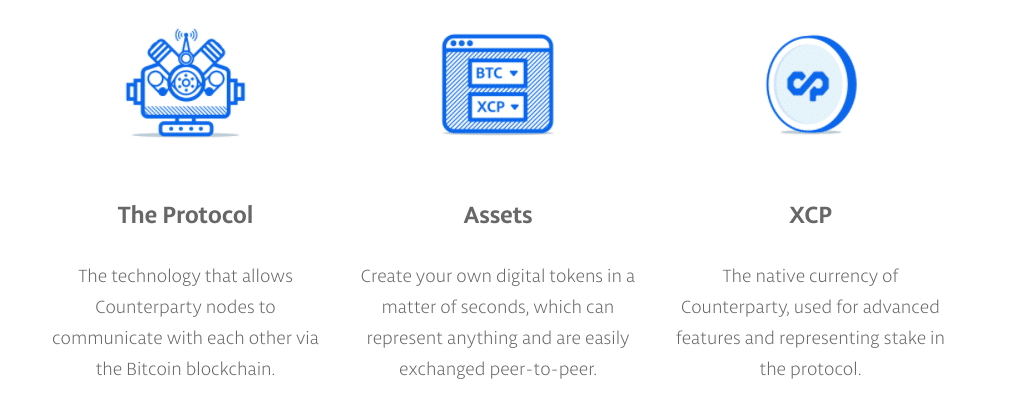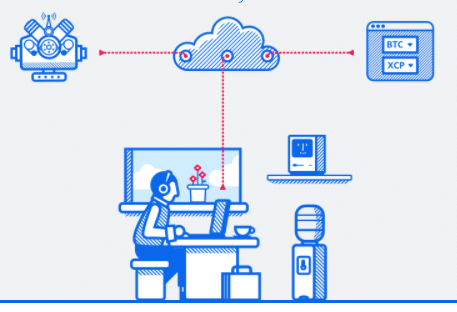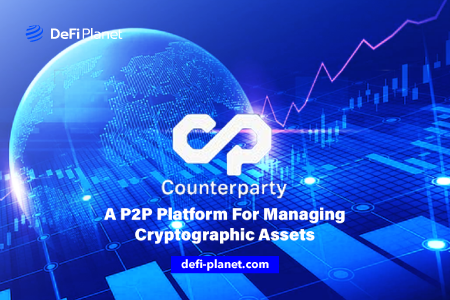In traditional finance, a counterparty refers to the individual or party involved in a transaction. However, in Web3, Counterparty is a protocol similar to Metacoin. It allows for the creation of tradable, user-generated currencies and decentralized asset exchange. The protocol was established in 2014 by Adam Krellenstein, Robert Dermody, and Evan Wagner.
Counterparty was built on top of the decentralized and open Bitcoin network. It has a decentralized exchange and token that enables users to create, buy, and sell their digital assets. While this is now a standard feature on platforms like Solana and Ethereum, Counterparty’s launch was an important event in digital history. It demonstrated that Bitcoin’s design could be extended to any asset or transaction that requires some form of verification, not just an alternative form of money or a store of value.
Moreover, Counterparty played a significant role in the global crypto art and collectibles movement. Projects like Rare Pepes in 2016 and Spells of Genesis in 2015, both seen as vital precursors to the current NFT boom, owe a debt of gratitude to the Counterparty protocol.
This article will provide an overview of Counterparty, explaining its unique features and how it works.
What is Counterparty?
Counterparty is a decentralized platform that allows users to create and trade custom tokens and smart contracts. It operates using a digital currency called Counterparty token (XCP), and it is based on the same technology as Bitcoin.
Unlike some other cryptocurrencies, the Counterparty token cannot be mined, and it was not offered through an initial coin offering (ICO). Instead, it was created using a process called “proof of burn.” This involves transferring a certain amount of bitcoins to a verified unspendable address, resulting in the creation of Counterparty tokens on the Bitcoin blockchain. The proof of burn process is designed to ensure that token creation is fair and not controlled by a small group of people.
Proof-of-Burn (PoB) is a consensus mechanism used for transaction validation and verification. This algorithm enables miners to effectively burn coins while consuming zero energy. PoB operates on the premise that miners can “burn” virtual currency tokens (by sending them to an unspendable address, similar to locking them away forever), allowing them to create new blocks in proportion to the amount of coins burned. PoB reduces the possibility of cryptocurrency double-spending.
This “proof of burn” approach means everyone, including the project’s founder, has an equal chance to participate. In total, 2.65 million XCP tokens were created by burning 2130 bitcoins, which are now being used to create custom tokens and smart contracts.
Features of Counterparty
Decentralized Asset Exchange
Counterparty claims to operate the first successful DEX (i.e., decentralized exchange). This means the exchange allows users to trade various assets on the platform without the need for a central institution to matchmaker and taker pairs.
This is significant because most financial institutions charge processing fees to facilitate transactions. In contrast, with Counterparty, users keep control of their funds throughout the transaction, eliminating the need to trust third parties with their funds.

User-Created Assets
Not all blockchain assets can be termed “tokens.” However, anything that is rare or that has value can be considered an asset. Counterparty sets itself apart from other blockchain platforms by not limiting itself to tokens; instead, it enables users to create digital assets of any form.
These digital assets can have various functions, including designating physical products, simplifying stock management, or enhancing a website’s reputation. Counterparty allows you to create them all.
Counterparty provides guidelines, requirements, and integrations to make asset creation on the Bitcoin blockchain easier. While Ethereum’s ERC-20 protocol also allows for user-created assets, Counterparty’s association with Bitcoin offers unique advantages, such as the ability to execute contracts using Bitcoin data.
However, Counterparty transactions are subject to Bitcoin mining fees, similar to how ERC-20 tokens have to pay ETH gas for token contract execution.

Asset Distribution and Voting Contracts
Counterparty offers users the ability to distribute digital assets as a means of indicating ownership or voting rights. For instance, Mr. A could distribute a digital asset to each of his company’s board members in proportion to their voting power or to his stockholders in proportion to the amount of stock they own.
Using Counterparty’s distribution function, Mr. A could distribute dividends in BTC to each individual based on their ownership amount by issuing a digital stock asset.
Furthermore, Counterparty allows users to execute voting contracts by distributing a voting token, which is proportional to the voting share. Voters can cast their votes by sending their tokens to designated contract addresses, depending on whether they are voting in favor (yes) or against (no). The contract with the most voting tokens would be declared the winner.
Contracts for Digital Assets
Counterparty is a platform that enables complete contracts for digital assets. These contracts can be configured to execute based on user input or external information provided by Oracles. By doing so, Counterparty can make copies of various financial instruments, including bets, stock options, escrow, and futures trading.
Moreover, users can build an API integration to connect their smart contracts with other software or external sources. These contracts work similarly to Ethereum’s smart contracts and even support Solidity, the programming language used to power Ethereum contracts.
How Counterparty Works
Counterparty allows data to be embedded into Bitcoin transactions. The transactions appear normal to regular Bitcoin clients and involve sending a small amount of bitcoin from one individual to another. However, a Counterparty node can interpret and identify the data based on predefined rules. The node then records the Counterparty transaction it observed on the Bitcoin network in its ledger.
To illustrate how Counterparty works, consider this transaction where one address sends 48 SJCX tokens to another address. On blockchain.info, the transaction is displayed, showing that just enough Bitcoin was transmitted to pay the miners for incorporating the transaction into a block. Essentially, the user paid the Bitcoin network for safeguarding and preserving the embedded Counterparty data.
Limitations Of Counterparty
Counterparty aims to be the leading protocol for Bitcoin 2.0 by offering various blockchain features such as asset creation, management, and bid placement. However, despite its advantages, Counterparty has a significant limitation.
Every aspect of Counterparty’s functionality is excessive. Features like dividends on assets have been pushed into the same overly convoluted protocol rather than being built as layers above preceding ones.
Bitcoin betting is a practical function, but by incorporating it into the core protocol, Counterparty has made it more challenging and experimental, complicating the valuable asset feature.
It would be more beneficial to develop simple and straightforward layers, each specializing in a single task and stacking on top of each other. For example, building mechanisms to deliver dividends in pure Bitcoin could be kept separate and easy to manage from establishing assets.
Counterparty’s functionalities can be better achieved by developing separate, compatible layers.
Notable Projects on Counterparty
Many notable projects have been launched and supported on Counterparty since its inception. Some examples are:
HODLpet
HODLpet is a virtual pet, and it claimed to be the first “living creature” to appear on the Bitcoin blockchain. Similar to the popular Tamagotchi video game, HODLpet is cared for by a group of HODLers. Another similarity would be to a community-driven, choose-your-own-adventure story. HODLpet provides extra features, including playable NFT card games and NFT artwork produced by popular artists.
Rare Pepes
The first Rare Pepes were made in September 2016 to meet the demand for collectible assets on-chain. These meme images could be bought and sold with Bitcoin or XCP.
There’s still a thriving ecosystem on Counterpart where collectors can buy original cards and later fake rare, dank rare, and fake common cards.
Bassmint
Bassmint is a cryptographic music directory and label on Counterparty. It was developed by a group of Bitcoin musicians, artists, and technologists who have been using Bitcoin for a long time.
Artists can use Counterparty to mint their music, have it curated on Bassmint, and be paid in bitcoin directly by fans.
Spells of Genesis
The first blockchain trading card (i.e., FDCARD) was released by EverdreamSoft on the Counterparty platform in March 2015. This was later used in Spells of Genesis (its strategic blockchain card game).
Players gather, trade, and merge assets known as “ORBs” to assemble top-performing decks on the Bitcoin blockchain. These decks can be challenged by other players, allowing players to compete and immerse themselves in the imaginative world of Askian.
Phockheads
One of the first digital collectibles, Phockheads, was lying dormant and almost forgotten on Namecoin (an early blockchain platform that started as a fork of Bitcoin). Counterparty brought them back to life by rescuing them and giving them a new home.
In Conclusion
- Counterparty addresses similar concerns as Ethereum and Waves, but it does so using the Bitcoin blockchain. Although this offers some benefits, it is not as strong of a development platform as its counterparts. Counterparty is most effective for applications that need to work with Bitcoin or for assets closely related to the Bitcoin ecosystem.
- Despite its limitations, Counterparty is still relevant due to a range of enduring projects and memes associated with the protocol. It also has an important place in the history of NFTs. Now, it is more accessible than ever through the Ethereum Emblem Vault.
If you would like to read more articles like this, visit DeFi Planet and follow us on Twitter, LinkedIn, Facebook, and Instagram, and CoinMarketCap Community.
“Take control of your crypto portfolio with MARKETS PRO, DeFi Planet’s suite of analytics tools.”





















